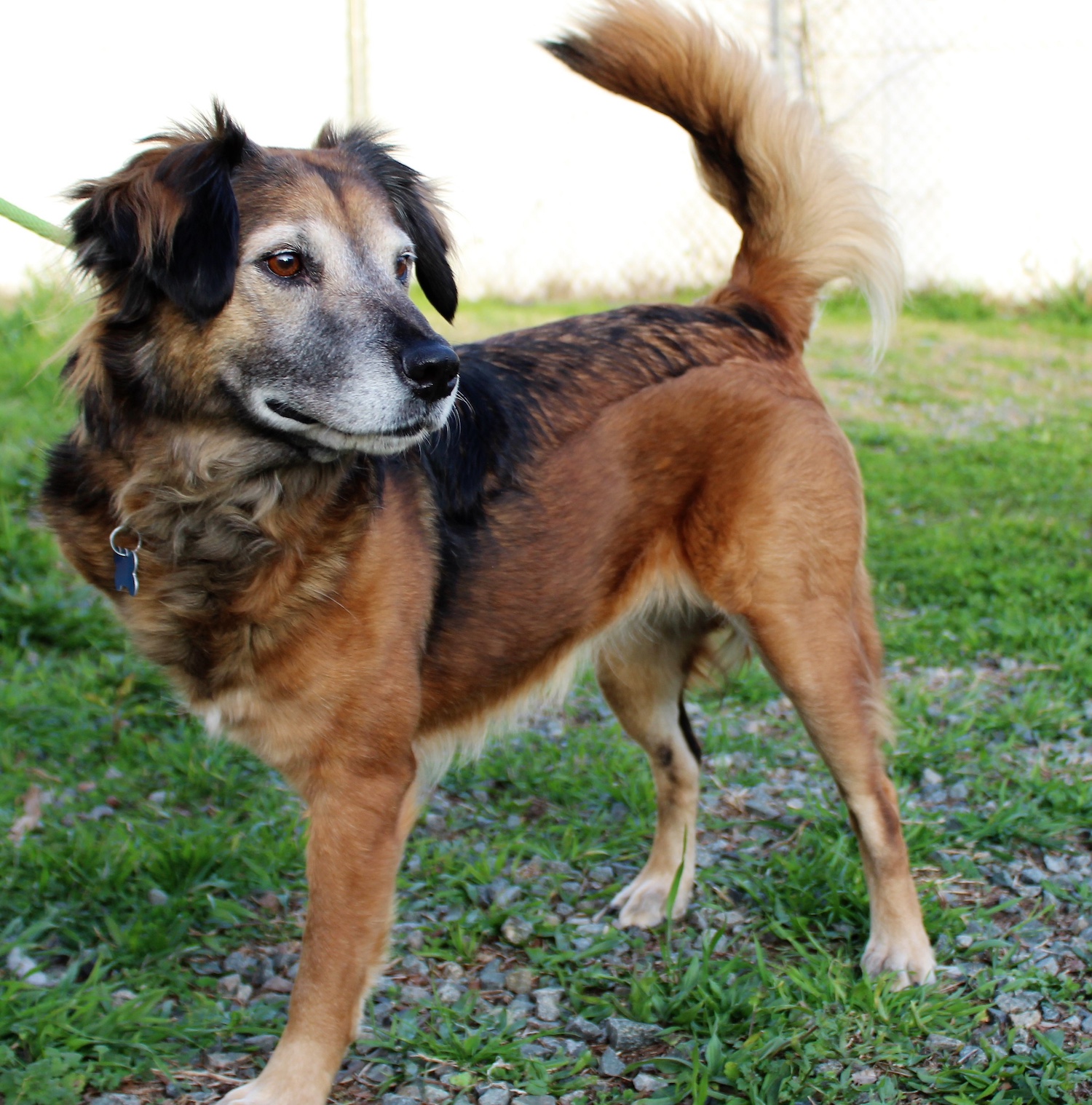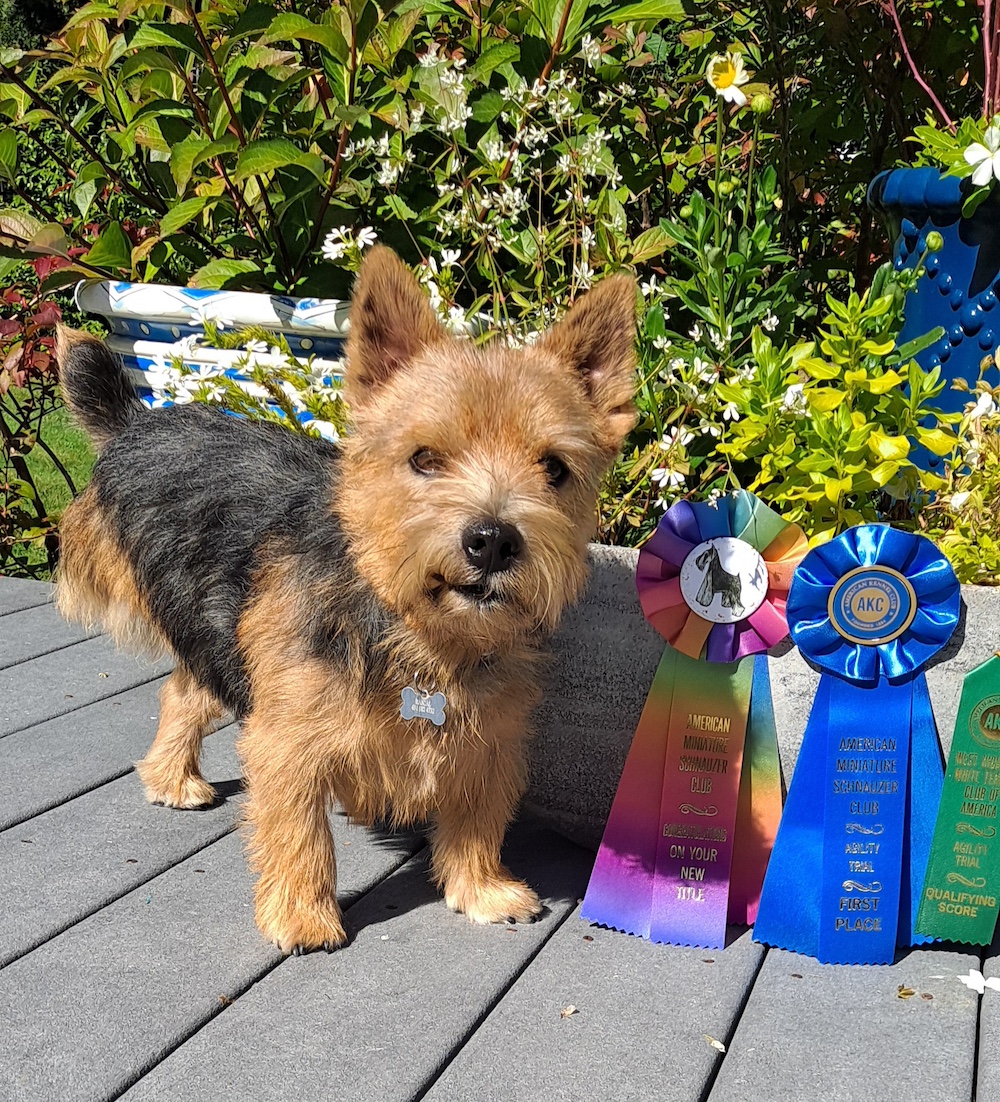Rascal, a five-year-old Norwich terrier, competes at agility events. You can see videos of him zipping around courses with his person, Lark Shlimbaum—navigating seesaws, tunnels, and jumps, cheerfully barking as he goes. Agility is an impressive achievement for any dog, but Rascal is the first of his kind—at least when it comes to official American Kennel Club agility events. He’s running the courses on three legs. Three-legged dogs weren’t permitted in such competitions until Shlimbaum and others campaigned for the AKC to change its rules. Now, Rascal is a regular presence at trials.

Rascal competing at agility. Photo: Kathy Dougherty
“One of the things people said to my husband and me,” says Shlimbaum of the time period when Rascal was set to have a limb amputated due to cancer, “was, ‘it’s going to be way harder on you than it is on the dog’— and that’s true.” To hear Shlimbaum tell it, Rascal behaves as if he doesn’t even know he’s missing a leg.
This is to say that a three-legged dog can have an active, normal life. Not all dogs missing limbs can or should compete in sports, but they should all get to do things that they enjoy. Here’s what Shlimbaum and a veterinarian experienced in rehabilitation and working with disabled pets have to say about keeping tripods happy and healthy.
Many dogs do well on three legs
Rascal’s athletic achievements are on the high end for dogs with any number of legs. But Jonathan S. Block, DVM, founder of West Delray Veterinary in Florida, says that, for the most part, dogs who are otherwise healthy can live fulfilling lives after losing a limb. This is important to keep in mind—both for those considering adopting a tripod, and for those whose veterinarians have recommended amputation. Dr. Block acknowledges that taking such a measure for a sick or injured dog is “sometimes hard for people to process.” But he’s also seen it improve dogs’ lives.

“Most dogs do okay if they’re not overweight,” says Dr. Block of adjusting to life on three legs. “They’re very adaptable creatures, and as long as the humans involved are set up for success with the proper education and resources, we’re generally able to facilitate and foster a smooth transition.”
Of course, amputation is a major decision, and you should feel free to ask your vet tough questions and seek out as much information as you can about your dog’s options—but don’t feel like you’re dooming a dog to misery if they lose a limb. Most tripod dogs acclimate to their new realities and enjoy their lives. Often, they fare better post-amputation without the pain they’d experienced in the limb.
Three-legged dogs need extra care
The fact that most dogs can live good lives on three legs does not mean that you can ignore their condition; they’ll need you to look out for their wellbeing.
Don’t rush your dog’s recovery
The period after surgery can be delicate. Follow your vets’ instructions, complete all courses of medication, and don’t let your dog rush back to full activity too quickly. Even Rascal didn’t proceed until he got the go-ahead from multiple vets. You want your dog to have a great life, not just a brief moment of fun; be deliberate in following the rehabilitation plan provided by your vet. They’ll give you guidance about monitoring the incision site, keeping any bandages clean and dry, and signs that you need to get back in touch with them.
You may have to carry your dog or give them other assistance moving around, at least for a while. Dogs are not generally known for long-term judgment; you’ll have to help them pace themselves.
Take precautions—but let your dog exercise
Dr. Block recommends “lifestyle and activity modification” for dogs after they’ve had an amputation. This does not mean foregoing exercise, which is crucial for all dogs. An appropriate amount and type of exercise can help tripods stay healthy. But Dr. Block says to focus on “safe and controlled exercise”—activities that are either on leash or in a controlled area.
Many tripods, Dr. Block says, could be in danger if they’re playing off leash with groups of other dogs. “Take a two-year-old pit bull or Labrador,” he says, “who doesn’t really have much of a governor on their own limitations. If there’s a ball being thrown or there’s other fun being had, those dogs are going to do as much as they can to participate in the fun and not understand that it could have consequences.” It’s up to you as the person to make sure the fun your dog has is also safe.
As your dog gets used to their new normal, and you both get a sense of how they can move and interact with other dogs, it’ll be easier to sort out which activities are suitable for them.

Rascal in action, running and barking. Photo: Donna Bielawski
Get your dog the right team
Dr. Block says that massage therapy, physical therapy, and other ongoing measures can help a tripod stay in good health. Massage therapists and physical therapists, he says, “can work on potential minor injuries or minor compensatory changes so that they don’t turn into major injuries or major long-term compensatory changes.” This is especially key for tripods who take part in sports. To figure out what plan makes sense for your dog, talk to your vet.
Regular veterinary checkups are a must for tripods. You want to pick up any subtle issues with their joints and muscles before they become bigger problems.
Keep your dog fit
Feed your tripod dog the right amount of complete and balanced food—not too much—and give them enough physical activity. Keeping any dog in an ideal body condition can help extend their lifespan and bolster their quality of life, and overweight dogs tend to develop arthritis earlier than those who are leaner. Extra weight means additional pressure on the joints, which can be a bigger problem for dogs who are distributing their weight on fewer legs.
Shlimbaum says she pays particular attention to Rascal’s shape. “You have to watch his weight,” she says. “You can’t [risk hurting] another leg under the circumstances.” She also modified Rascal’s agility routine: he jumps at a lower height than before, and turns left more than right because of his changed body. They’ve added rugs to their house to improve his grip on the ground. And before even deciding that Rascal would continue to compete, Shlimbaum says, she and her husband consulted “two oncologists, his surgeon, his vet, his physical therapist,” and others for advice. Once they got the green light, they proceeded with appropriate precautions.
Provide tools if your dog needs them
Some dogs may need assistive devices—like special harnesses or prosthetic limbs—to help them get around. Others will have good mobility without them. Similarly, some tripod dogs may benefit from joint supplements that can limit or prevent future joint problems. Talk to your vet and the rest of your dog’s veterinary healthcare team about what choices are right for them.
While it doesn’t happen to most tripod dogs, Dr. Block says that some of them can experience unexpected consequences like phantom pain. When this does arise, he says, it can usually be managed with medication.

Every dog is different, and so is every person
Every tripod dog, just like every dog in general, will have their own personality. Some of them may act as though nothing is wrong once they’ve physically recovered from surgery. Shlimbaum reports that Rascal bounced back right after his leg was amputated. He’d competed in agility before, continued to do so through his medication, and resumed his routine soon after surgery. “We got him [back] on Wednesday,” she remembers. “Thursday, we went to class. We said, ‘Let’s take him to a couple of obstacles and see what he looks like,’ and he ran a full agility course.” There were modifications and a slow ramp-up of physical activity—but as far as his enthusiasm went, Rascal did not miss a beat.
This is not universal among tripod dogs, some of whom have a tougher time with the physical and mental aspects of their recoveries. Depending on which limb a tripod dog has lost, the circumstances under which they lost it, and myriad other factors, their abilities and what’s safe for them to attempt may vary. Care for them and train them according to what they can do, and what they want to do. Especially early in recovery, brain games may give your dog something pleasant to do, and keep them mentally active, even when their physical capabilities are limited. You may be surprised at how tiring a food puzzle can be for a dog who’s mentally ready to run, but is on temporary crate rest under doctor’s orders.
“Be open-minded,” says Dr. Block, “and try to just consider the needs of the dog.”

Rascal with some of his ribbons. Photo: Lark Shlimbaum
What routine is right for your dog, says Dr. Block, “really is subjective, based on [your] goals and expectations for what constitutes a good quality of life.” Listening to the signals your dog gives you, and in consultation with their veterinary healthcare team about their abilities, you’ll have to weigh the risks and benefits of certain activity levels. But whether it’s a few short walks a day, food puzzles, scavenger hunts, or sports, tripod dogs should have fun in their lives.
Shlimbaum is grateful that she was able to keep Rascal involved in his favorite activities. “He was two years old,” she says, remembering his age when he needed an amputation. “What, am I going to throw him away? His personality was the same. He was the same dog, as far as I could tell, just minus a limb.”









